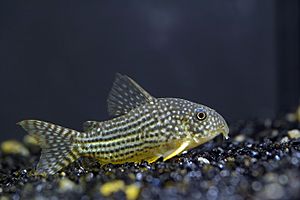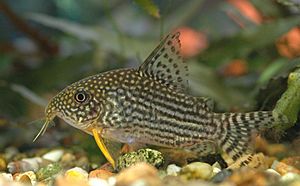Sterba's corydoras facts for kids
Quick facts for kids Sterba's corydoras |
|
|---|---|
 |
|
| Scientific classification |
The Sterba's corydoras (Corydoras sterbai) is a popular type of catfish. It lives in freshwater and is often kept in home aquariums. This fish comes from the Guaporé River area, which is between Bolivia and Brazil in South America. People love them because of their cool patterns.
You can tell a Sterba's corydoras apart by the white spots on its black head. Sometimes, people confuse it with another fish called Corydoras haraldschultzi. But that fish has black spots on a white head. You can also find Sterba's corydoras in special white (albino) or black forms.
Like many Corydoras fish, Sterba's corydoras likes to live in groups. It's best to keep at least five of them together. In the wild, they prefer soft, slightly acidic water. But fish raised in tanks can live in many different water types. Just make sure the water is clean and doesn't have too many nitrates.
These catfish are not good at eating algae. But they are great at cleaning up leftover food and tiny bits from the bottom of the tank. They are quite small for catfish, growing to about 2 to 2.6 inches (5 to 6.6 cm) long.
Contents
Caring for Sterba's Corydoras in an Aquarium
In a fish tank, Sterba's corydoras will eat many kinds of food. They like flake food that sinks to the bottom. Sinking pellets or wafers are also good. They enjoy live or frozen foods like bloodworms or daphnia. But these high-protein foods should only be given once a week.
Sometimes, it's hard to feed Corydoras if you have fast-eating fish like tetras. These faster fish might eat all the food before it reaches the bottom. You can solve this by putting food in caves or under bogwood. This way, the slower-eating catfish can get their share.
Sterba's corydoras are very peaceful fish. This makes them great tank mates for other calm fish. They should not be kept with aggressive fish that live at the bottom of the tank. This is especially true in small tanks where space is limited. Good tank friends include small tetras or dwarf cichlids.
It's best to have a soft bottom in their tank, like sand or fine gravel. This protects their delicate whiskers (called barbels). If you use larger gravel, make sure it's not sharp. They also need shady spots to hide. You can create shade with rocks, large plants, or caves.
How Sterba's Corydoras Reproduce
Breeding these fish is not too hard. A tank about 18 by 12 by 12 inches (45 x 30 x 30 cm) is a good size. It's best to have two male fish for every female fish. Feeding them well and changing the water often can help them breed. Lowering the water temperature a little can also encourage them. However, raising the baby fish can be tricky because they are very sensitive.
Sometimes, these fish can release a special chemical if they get stressed. This can happen if they are crowded or moved. Because of this, they are usually shipped by themselves, not with other fish.
Why They Are Called Sterba's Corydoras
This fish is named after Professor Dr. Günther Sterba. He was a professor of zoology at Leipzig University. Professor Sterba was a fish expert who wrote many popular books. These books were like guides for fishkeepers in the 1970s and 1980s. His books were translated into English, including Freshwater Fishes of the World.
See also
 In Spanish: Corydoras sterbai para niños
In Spanish: Corydoras sterbai para niños
- List of freshwater aquarium fish species



